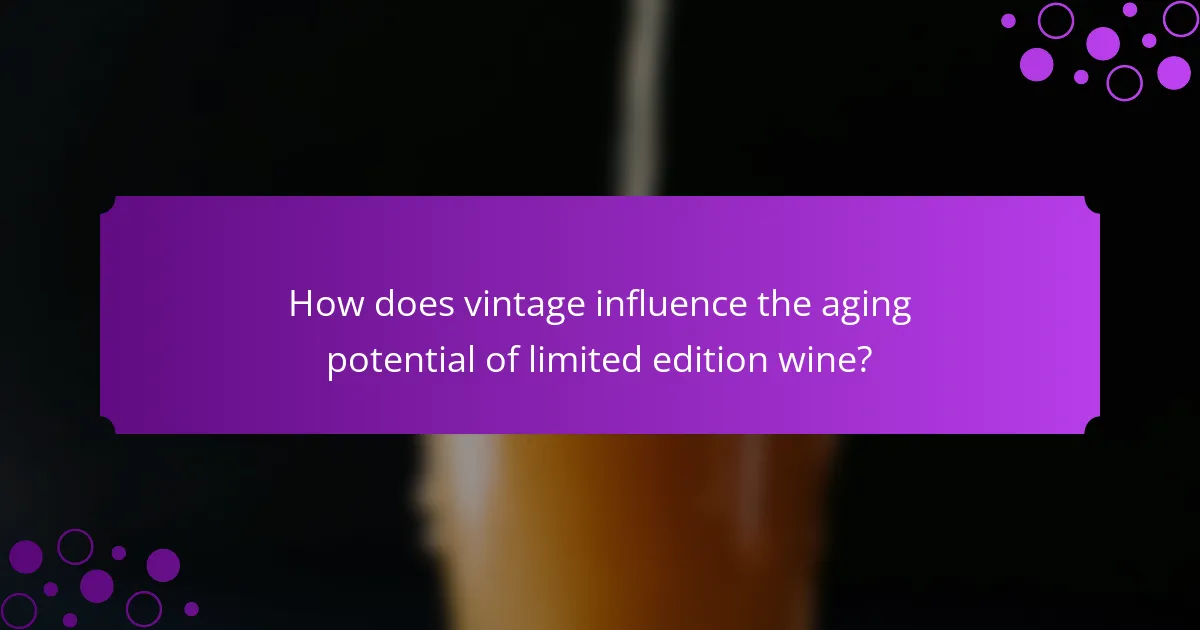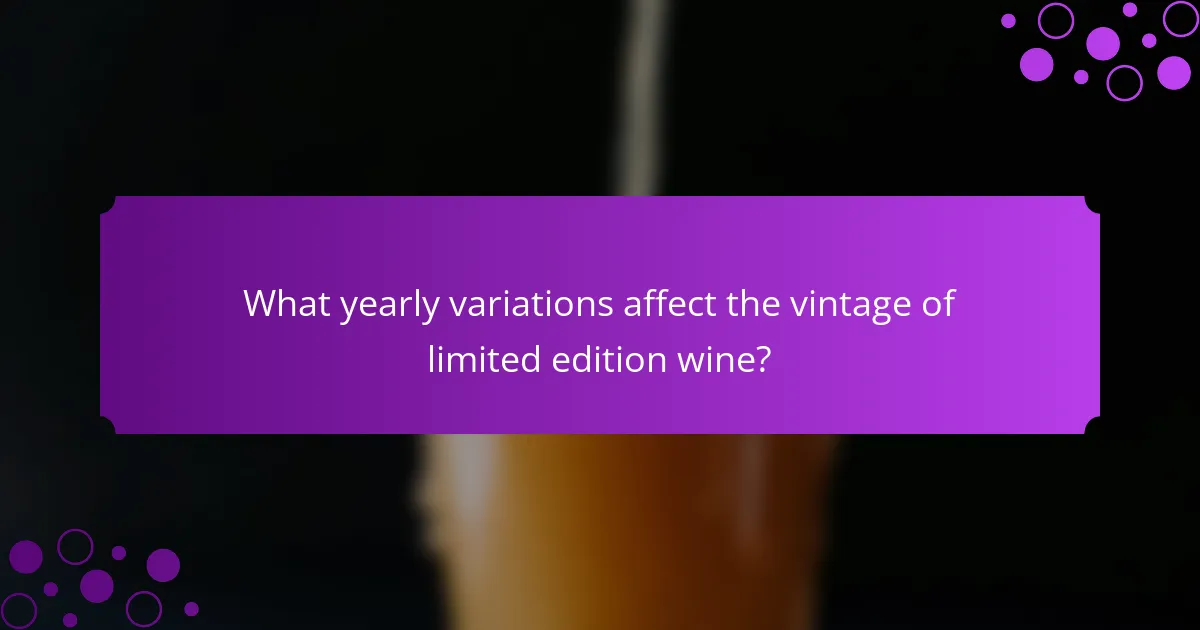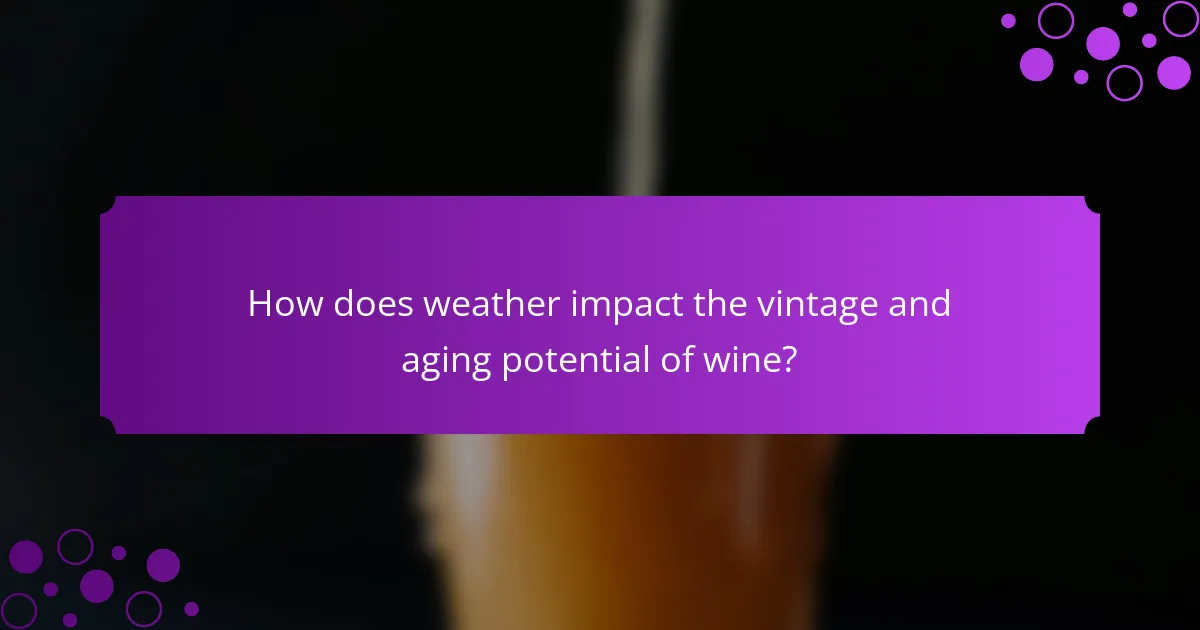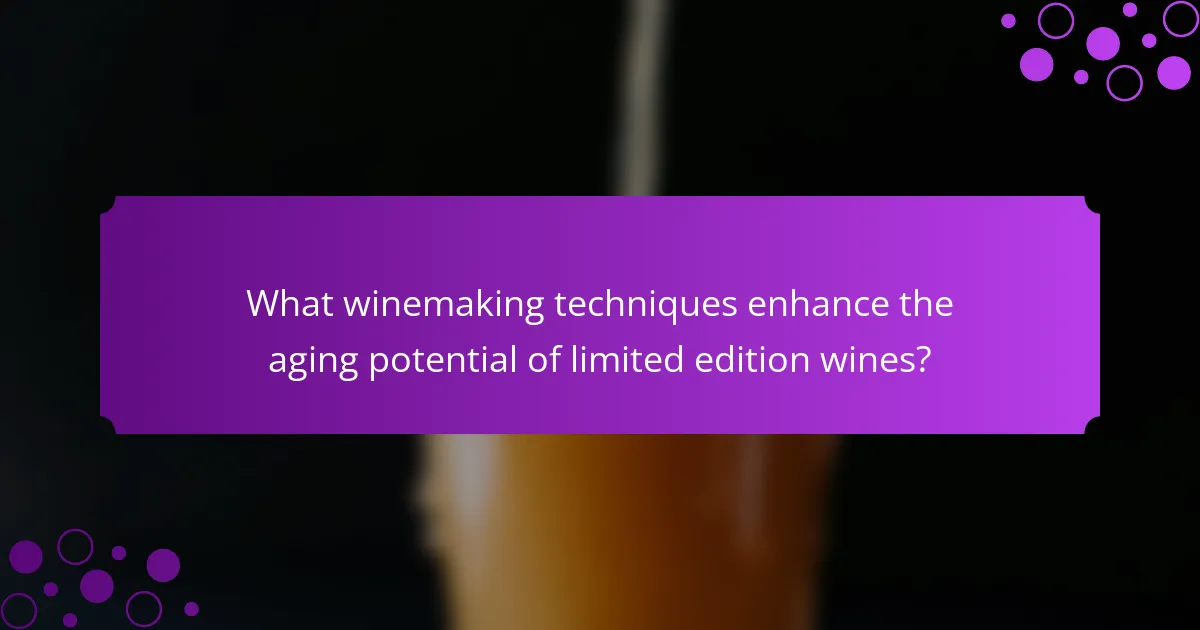
How does vintage influence the aging potential of limited edition wine?
Vintage significantly influences the aging potential of limited edition wine. The year of production affects the grape quality, which is critical for aging. Weather conditions during the growing season impact sugar levels, acidity, and tannin structure. These factors determine how well a wine will develop over time. For example, a vintage with optimal ripening conditions usually results in wines that age gracefully. In contrast, a challenging vintage may lead to wines that do not mature as well. Historical data shows that certain vintages are celebrated for their longevity. The 2005 Bordeaux vintage is often cited for its exceptional aging potential due to favorable weather and careful winemaking techniques. Thus, vintage serves as a crucial indicator of a limited edition wine’s ability to evolve and improve with age.
What factors contribute to the concept of vintage in wine?
The concept of vintage in wine is primarily influenced by the year of grape harvest. Factors such as climate conditions, soil quality, and vineyard management play crucial roles. Weather variations, including temperature and rainfall, directly affect grape ripeness and flavor. Soil composition contributes to the unique characteristics of the grapes. Winemaking techniques, including fermentation and aging processes, also shape the final product. Historical data shows that certain years produce exceptional wines due to favorable conditions. For instance, the 2015 Bordeaux vintage is renowned for its high quality, attributed to ideal weather patterns. These elements collectively define the vintage and its impact on wine quality and aging potential.
How is vintage defined in the context of limited edition wines?
Vintage in the context of limited edition wines refers to the year in which the grapes were harvested. This year is crucial as it significantly influences the wine’s characteristics. Factors such as weather conditions, grape quality, and winemaking techniques during that year impact the final product. For example, a vintage from a year with ideal growing conditions often results in higher quality wine. The term is also used to denote the specific bottle or batch of wine produced from that harvest. Limited edition wines often highlight their vintage to attract collectors and enthusiasts. This emphasis on vintage can affect the wine’s market value and aging potential.
What are the historical perspectives on vintage in winemaking?
The historical perspectives on vintage in winemaking highlight its significance in assessing wine quality. Vintage refers to the year grapes are harvested. Historically, certain years have been celebrated for exceptional weather conditions, leading to superior grape quality. For instance, the Bordeaux vintage of 1982 is renowned for its outstanding wines due to favorable climate. Over time, regions have developed reputations based on their vintage years. In Burgundy, for example, the vintage of 1999 is noted for its remarkable Pinot Noir. Additionally, historical records from ancient winemaking cultures, like the Romans, indicate that vintage was already a consideration in their wine classifications. The emphasis on vintage continues to influence wine pricing and consumer preferences today.
Why is aging potential important for limited edition wines?
Aging potential is crucial for limited edition wines because it directly influences their quality and value over time. Limited edition wines are often crafted with unique characteristics that can evolve and improve with age. As these wines mature, they develop complex flavors and aromas, enhancing the overall tasting experience.
For instance, tannins and acidity in wine soften over time, leading to a smoother palate. Additionally, the aging process allows for the integration of various flavor compounds, creating a harmonious blend. Wines with high aging potential can also appreciate in market value, making them attractive to collectors and investors.
Historical data shows that certain vintages, such as Bordeaux from exceptional years, have significantly increased in value as they aged. This trend reinforces the importance of aging potential in limited edition wines, as it not only affects their sensory profile but also their economic worth.
What characteristics define a wine’s aging potential?
A wine’s aging potential is defined by its acidity, tannin structure, and fruit concentration. High acidity helps preserve the wine over time. Tannins contribute to a wine’s structure and complexity as it ages. Concentrated fruit flavors indicate a wine’s ability to evolve positively with time. Additionally, the presence of phenolic compounds can enhance aging potential. Wines with these characteristics often develop more complex flavors and aromas as they mature. Studies show that wines with balanced acidity and tannins can age for decades, improving in quality.
How does aging affect the flavor profile of limited edition wines?
Aging enhances the flavor profile of limited edition wines by allowing complex chemical reactions to occur. During aging, tannins soften, resulting in a smoother mouthfeel. Oxidation can introduce new flavors, such as nuttiness or caramel. The interaction with oak barrels adds notes of vanilla, spice, and toast. Over time, fruity flavors may evolve into more savory or earthy tones. The duration of aging significantly influences these changes. Studies show that wines aged for longer periods often exhibit greater complexity. For example, Bordeaux wines typically improve with at least 10-15 years of aging. These transformations contribute to the wine’s overall quality and desirability.

What yearly variations affect the vintage of limited edition wine?
Yearly variations that affect the vintage of limited edition wine include climate conditions, rainfall, temperature, and sunlight exposure. Each year, these factors can significantly influence grape ripeness and flavor profiles. For instance, warmer summers can lead to higher sugar levels in grapes. Conversely, cooler temperatures may result in lower alcohol content and higher acidity. Rainfall patterns also affect vineyard practices. Excessive rain can lead to dilution of flavors or increased disease risk. Limited edition wines often rely on specific weather conditions to achieve their desired characteristics. Historical data shows that certain vintages are celebrated due to optimal weather patterns. For example, the 2010 Bordeaux vintage is noted for its ideal growing conditions, leading to exceptional quality.
How do different growing seasons impact wine vintage?
Different growing seasons significantly impact wine vintage. Variations in temperature, rainfall, and sunlight during these seasons influence grape development. For instance, warmer growing seasons typically lead to riper grapes with higher sugar levels. This can result in wines with increased alcohol content and different flavor profiles. Conversely, cooler seasons may produce grapes with higher acidity and lower sugar levels, impacting the wine’s balance and aging potential. Historical data shows that exceptional vintages often correlate with optimal growing conditions, such as the 2010 Bordeaux vintage, which benefited from a warm and dry summer. These seasonal conditions directly affect the characteristics of the wine, influencing both immediate taste and long-term aging potential.
What climatic conditions are ideal for producing high-quality vintages?
Ideal climatic conditions for producing high-quality vintages include a balance of sunlight, temperature, and humidity. Warm days and cool nights are essential for optimal grape ripening. Sunlight aids in sugar development while cooler temperatures preserve acidity. A moderate climate prevents excessive rainfall, which can lead to disease. Well-drained soils also contribute to healthy vine growth. Regions like Bordeaux and Napa Valley exemplify these conditions. Historical data shows that consistent weather patterns enhance vintage quality. For instance, the 2010 Bordeaux vintage was praised for its ideal climatic conditions.
How do temperature and rainfall variations affect grape quality?
Temperature and rainfall variations significantly affect grape quality. Higher temperatures can lead to increased sugar levels in grapes. This can enhance sweetness but may reduce acidity. Conversely, lower temperatures can preserve acidity, impacting flavor balance. Rainfall influences water availability for vines. Excess rainfall can lead to dilution of flavors and increased disease risk. Insufficient rainfall can stress vines, affecting berry size and concentration. Studies show that optimal temperature ranges for quality grapes are between 20°C to 30°C. Research indicates that rainfall during critical growth phases can alter phenolic compounds, influencing color and taste. Thus, both temperature and rainfall are crucial for determining grape quality.
What role does harvest timing play in vintage quality?
Harvest timing significantly influences vintage quality. It determines the sugar levels, acidity, and phenolic compounds in grapes. Early harvest can lead to higher acidity and lower sugar, resulting in fresher wines. Late harvest allows for increased sugar concentration, yielding richer and fuller-bodied wines. The balance between these factors directly impacts the wine’s flavor profile and aging potential. Studies show that optimal harvest timing correlates with better vintage ratings from experts. Historical data indicates that regions with precise harvest timing often produce award-winning wines. Thus, harvest timing is crucial for achieving desired wine characteristics and overall quality.
How does early versus late harvest influence wine characteristics?
Early harvest produces wines with higher acidity and lower sugar levels. This results in a fresher taste and more vibrant fruit flavors. Wines from early harvest often exhibit green, herbaceous notes. They tend to be lighter in body and have a crisper finish.
In contrast, late harvest allows grapes to accumulate more sugars. This leads to fuller-bodied wines with richer flavors. Late-harvest wines often feature notes of dried fruit and honey. They may also have lower acidity, resulting in a smoother mouthfeel.
Research shows that the timing of harvest directly affects the balance of sugar and acidity. A study published in the Journal of Wine Research indicates that harvest timing significantly influences overall wine quality and aging potential.
What are the risks associated with different harvest timings?
Different harvest timings can lead to several risks for wine quality. Early harvest can result in higher acidity and lower sugar levels. This may produce wines that lack balance and flavor complexity. Late harvest, on the other hand, risks over-ripening. This can lead to overly sweet wines with reduced acidity.
Additionally, harvest timing can influence the phenolic development in grapes. If grapes are harvested too late, they may have excessive tannins. This can create astringent wines that are less enjoyable. Weather conditions also play a crucial role. Unexpected rain or frost can damage grapes and affect their ripeness.
Furthermore, pest and disease pressures can increase with delayed harvesting. Grapes left on the vine too long may attract more pests. This can lead to lower yields and compromised quality. Overall, careful consideration of harvest timing is essential for optimal wine production.

How does weather impact the vintage and aging potential of wine?
Weather significantly influences the vintage and aging potential of wine. Climate conditions during the growing season affect grape ripeness and acidity levels. For instance, warmer temperatures can lead to higher sugar content in grapes. This sugar converts to alcohol during fermentation, impacting the wine’s flavor profile. Additionally, rainfall patterns affect grape yield and disease prevalence. Excessive rain can dilute flavors and increase the risk of rot.
Temperature fluctuations during harvest season also play a crucial role. Cooler nights can preserve acidity, enhancing aging potential. Historical data shows that vintages from regions with optimal weather conditions often receive higher ratings. For example, the 2015 Bordeaux vintage was praised for its ideal weather, resulting in wines with excellent aging potential. Thus, weather directly correlates with the quality and longevity of wine.
What weather patterns are most significant for winemaking?
Temperature, precipitation, and humidity are the most significant weather patterns for winemaking. Temperature influences grape ripening and sugar accumulation. Ideal temperatures range between 20°C to 30°C during the growing season. Excessive heat can lead to overripe grapes and high alcohol levels. Precipitation affects soil moisture and vine health. Adequate rainfall during the growing season is crucial for balanced grape development. Humidity impacts disease pressure and fruit quality. High humidity can increase the risk of fungal diseases like powdery mildew. Historical data shows that regions with consistent weather patterns produce higher quality wines. For instance, Bordeaux’s maritime climate benefits from moderate temperatures and well-timed rainfall, enhancing grape quality.
How do drought conditions influence grape development?
Drought conditions significantly influence grape development by limiting water availability. This stress can enhance the concentration of sugars in grapes. Higher sugar levels can lead to more robust flavors in the wine. Drought also encourages deeper root growth, which can improve the plant’s resilience. However, excessive drought can lead to shriveled grapes, reducing yield and quality. Studies show that controlled drought can improve grape quality, as seen in regions like Napa Valley. In these areas, drought conditions have been linked to increased phenolic compounds, contributing to better aging potential. Ultimately, drought impacts both the quantity and quality of grape production.
What effects do frost and hail have on vintage quality?
Frost and hail negatively impact vintage quality in wine production. Frost can damage young buds, reducing the potential yield. This loss leads to fewer grapes available for harvest. Hail can cause physical damage to the grapes, making them susceptible to rot. Both factors can lead to a decrease in sugar and acidity levels in the grapes. Lower sugar levels affect the fermentation process and overall flavor profile. Historical data shows that vintages affected by severe frost or hail often result in lower quality wines. For example, the 1991 Bordeaux vintage was significantly impacted by hail, resulting in lower ratings from critics.
How can winemakers mitigate adverse weather effects on vintage?
Winemakers can mitigate adverse weather effects on vintage through several strategies. They can implement irrigation systems to manage water supply during droughts. Cover crops can be planted to improve soil health and moisture retention. Additionally, using shade cloths can protect vines from excessive sun exposure.
Winemakers may also adjust harvest times to avoid extreme weather conditions. Utilizing advanced weather forecasting can aid in timely decision-making. Some winemakers invest in climate-controlled storage to preserve grapes during unpredictable weather.
Research indicates that these practices can enhance grape quality and yield. For instance, studies show that irrigation can increase resilience against drought stress.
What techniques are employed to protect vineyards from extreme weather?
Vineyards employ several techniques to protect against extreme weather. These include the use of windbreaks, which are barriers that reduce wind speed and protect vines. Additionally, irrigation systems are implemented to manage water supply during droughts. Shade cloths can be used to shield grapes from excessive sun exposure. Frost protection methods, such as heaters or sprinklers, help prevent frost damage during cold nights. Cover crops are planted to improve soil health and retain moisture. Mulching is applied to regulate soil temperature and moisture levels. Finally, vineyard design, including row orientation and elevation, is optimized to mitigate weather impacts. These methods collectively enhance the resilience of vineyards to adverse weather conditions.
How does climate change affect long-term vintage strategies?
Climate change significantly impacts long-term vintage strategies. It alters temperature and precipitation patterns, affecting grape growing conditions. Warmer temperatures can lead to earlier harvests, potentially altering flavor profiles. Increased rainfall may cause diseases in vineyards, impacting fruit quality. These factors can change the aging potential of wines. Research shows that climate variability affects vintage quality over time. A study by Jones and Goodrich (2015) indicates that consistent climatic conditions are essential for premium wine production. Thus, adapting strategies to evolving climate patterns is crucial for maintaining quality in vintage wines.

What winemaking techniques enhance the aging potential of limited edition wines?
Winemaking techniques that enhance the aging potential of limited edition wines include meticulous grape selection, controlled fermentation, and optimal barrel aging. Selecting high-quality grapes ensures the best raw material, which is crucial for aging. Controlled fermentation allows winemakers to manage temperature and yeast, impacting flavor development and stability.
Barrel aging in oak can impart tannins and compounds that contribute to a wine’s structure. This process also allows for micro-oxygenation, which softens tannins and enhances complexity. Extended maceration can extract more phenolic compounds, aiding in the development of flavor and aging potential.
Additionally, using specific yeast strains can influence the wine’s aromatic profile and longevity. Proper storage conditions, such as temperature and humidity control, further support the aging process. Collectively, these techniques create a balanced wine that can evolve favorably over time.
How do fermentation methods impact wine aging?
Fermentation methods significantly impact wine aging by influencing chemical composition and flavor development. Different methods, such as spontaneous fermentation and controlled fermentation, create varying levels of acidity and phenolic compounds. Spontaneous fermentation often leads to more complex flavor profiles due to wild yeast interactions. In contrast, controlled fermentation allows for precision in temperature and yeast selection, resulting in more predictable aging outcomes. The choice of fermentation vessel, like oak barrels versus stainless steel, also affects oxygen exposure and tannin extraction. Research indicates that wines fermented in oak often age better due to enhanced flavor complexity and structure. These factors collectively determine how well a wine can develop over time.
What role does oak aging play in developing flavor complexity?
Oak aging significantly enhances flavor complexity in wine. The process introduces various compounds from the wood, such as tannins and vanillin. These compounds contribute to flavors like vanilla, spice, and toast. Oak barrels also allow for micro-oxygenation, which softens tannins and promotes a smoother mouthfeel. This interaction creates a more layered and nuanced flavor profile. Studies show that wines aged in oak can develop greater aromatic complexity compared to those aged in stainless steel. For instance, a 2015 study by the University of California found that oak-aged wines exhibited increased sensory attributes, enhancing overall enjoyment.
How do different fermentation temperatures affect aging potential?
Fermentation temperatures significantly influence the aging potential of wine. Higher fermentation temperatures can enhance the extraction of tannins and polyphenols, which contribute to a wine’s structure and longevity. Wines fermented at lower temperatures tend to retain more acidity and freshness, which are also vital for aging. Studies show that optimal fermentation temperatures range between 20°C to 30°C for red wines and 15°C to 20°C for white wines. This range allows for a balance of flavor development and preservation of essential acidity. Research indicates that wines fermented at temperatures outside these ranges may develop undesirable characteristics, affecting their aging potential. For instance, fermentation above 30°C can lead to excessive volatile acidity, diminishing the wine’s quality over time.
What are the best practices for bottling and storage of limited edition wines?
The best practices for bottling limited edition wines include using high-quality glass bottles and corks. Bottles should be dark to protect the wine from light exposure. The bottling process must occur in a sterile environment to prevent contamination. Wines should be filled to the correct level to minimize air exposure. Storage conditions are crucial; wines should be kept in a cool, dark place with stable temperatures. Ideal storage temperature ranges from 50°F to 55°F. Humidity levels should be around 70% to keep corks moist and prevent oxidation. Bottles should be stored horizontally to maintain cork integrity. These practices ensure the wine retains its quality and aging potential over time.
How does bottle closure choice influence aging potential?
Bottle closure choice significantly influences the aging potential of wine. Different closures, such as cork, screw caps, and synthetic stoppers, affect oxygen permeability. Cork allows a small amount of oxygen to enter the bottle, which can enhance aging. This slow oxygen ingress helps develop complex flavors over time. In contrast, screw caps provide a tighter seal, limiting oxygen exposure. This can preserve the wine’s freshness but may inhibit aging potential. Studies indicate that wines sealed with cork can age effectively for decades, while those with screw caps may be best enjoyed within a shorter timeframe. Thus, the choice of bottle closure plays a crucial role in determining how a wine matures and develops its characteristics over time.
What storage conditions are optimal for preserving vintage quality?
Optimal storage conditions for preserving vintage quality include a stable temperature, controlled humidity, and minimal light exposure. A temperature range of 50-55°F (10-13°C) is ideal for wine storage. Humidity levels should be around 60-70% to prevent cork drying. Dark storage areas protect wines from UV light, which can degrade quality. Vibration should be minimized as it can disturb sediment and alter flavors. These conditions help maintain the wine’s integrity and enhance its aging potential. Studies indicate that wines stored under these parameters retain their characteristics longer, providing a better tasting experience over time.
What practical tips can wine enthusiasts use to evaluate vintage quality?
Wine enthusiasts can evaluate vintage quality by considering several practical tips. First, examine historical data on the specific vintage. Research shows that certain years are known for exceptional weather conditions, which influence grape quality. Second, assess the region’s climate during that vintage year. For instance, a warm growing season typically leads to ripe grapes with concentrated flavors. Third, read expert reviews and ratings from reputable wine publications. These sources often provide insights into the quality and characteristics of specific vintages. Fourth, look for tasting notes from trusted sommeliers or wine critics. Their evaluations can highlight the wine’s aging potential and flavor profile. Finally, consider the producer’s reputation and winemaking techniques. Established wineries often maintain consistent quality across vintages, which can be a reliable indicator.
The main entity of the article is vintage wine, specifically focusing on how vintage affects the aging potential of limited edition wines. The article explores various factors influencing vintage, such as yearly variations in climate, weather impacts during the growing season, and winemaking techniques that enhance aging potential. Key discussions include the significance of grape quality, harvest timing, and historical perspectives on vintage, alongside the role of storage conditions and bottle closure choices. Additionally, it addresses how specific climatic conditions and winemaking practices contribute to the overall quality and market value of vintage wines.